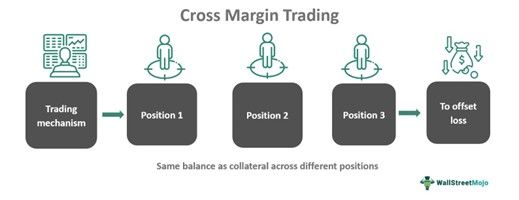Table Of Contents
What is Cross Margin?
Cross Margin is a trading choice that allows traders to utilize margin balances across their different positions. Under this arrangement, the equity or profit that becomes excess in margin requirement is used to cover another margin deficiency. In other words, it is used to offset loss from another position.

One of the main benefits of the arrangement is that, in certain situations, it helps in preventing forced liquidation and preventing margin calls of a losing position. The feature helps reduce and optimize existing margin requirements for traders with multiple open positions. It is a tool to make smart investment choices and increase an investor's trading capacity.
Key Takeaways
- Cross margin is a strategic method offered by trading platforms that lets traders use margin balances across different positions.
- It helps in offsetting losses by collecting a pool of available funds from their cross margin account to serve as collateral for the positions.
- The benefits provided include risk management, capital efficiency and increased trading capacity. However, losses in one position, if it is high, can impact other positions.
- It is different from the isolated margin, which is margining allotted for specific positions only and, hence, better suited for experienced traders.
Cross Margin Explained
Cross-margin is a trading mechanism that allows traders to handle multiple positions using their balance or margin as collateral from their cross-margin account. It is also known as spread margins. It essentially means that trader's funds are collected under a single pool, and all their positions use this one pool as collateral.
Under the method, the margin is shared between orders and open positions where a minimum margin requirement is needed to keep positions open. All of the positions are kept at the maximum allowed leverage to make this happen. The margining algorithms automatically add or remove funds or margins as prices move. In such circumstances liquidation will be triggered only if the whole of the balance is used up. It shall be noted that they work within contracts with the same settlement currencies.
The traders do not have to add or remove margins for every position opened. However, it is important to know that the profit and loss in one position can affect all other positions. If in case the trader has a number of highly leveraged positions, even if one position goes against the trader, it can result in possible liquidation. There could, however, be additional limitations, such as the possibility of margin calls, that can make the proceedings careful. This may hinder the diversification of the trader's investment portfolio as the margin requirements have to be rotated. This increases the risk of incurring losses.
Features
Given below are some of the features of cross-margining
- Automatic allocation - The arrangement automatically allocates the highest possible leverage for the chosen contracts (including the chosen quantity and leverage).
- Estimation of liquidation prices is difficult - The requirements are for the entire set of positions. It may not be possible to estimate liquidation prices for individual positions.
- Improved capital efficiency - Traders are allowed to shift their excess equity where there is a potential loss to balance out. Hence, capital can be used to the full extent.
- Risk management - The excess equity is transferred and hence can help to compensate for loss on one position from another position.
- Reduced margin requirements - The collateral pool serves the same for all positions and hence requires fewer amounts of margin requirements.
Examples
Let us look into some examples to understand the concept better.
Example #1 - A Hypothetical Example
Imagine a trader. Let's call him Dan.
Suppose a trader has a long position in commodity A and a short position in commodity B, and the exchange allows cross-margining.
If such an option is available, then Dan could use his available balance to keep collateral common for both commodities. This way, if he incurs a loss in one, he could leverage it for another. This way, he can prevent loss and make use of the available capital efficiently.
Example #2 - Real Life Example
The CME (Chicago Mercantile Exchange) group, the world's leading platform for derivatives, has announced cross margining arrangement with the DTCC (the Depository Trust and Clearing Corporation). The new arrangement is expected to bring in more trading and cost efficiency. It is available to the eligible clearing members of GSD (government securities division of DTCC's FICC (fixed income Clearing Corporation) for both cash and futures.
Benefits
Given below are some of the benefits offered by cross margin trading.
- It raises liquidity and lowers net settlements.
- It helps in risk management by using the full account amount for collateral purposes and can help restrict individual holdings from premature liquidation.
- It brings in chances of gaining a higher return owning to greater leverage.
- Cross-margin trading is used as a hedging method to prevent risks.
Cross Margin vs. Isolated Margin
Given below are some of the points of differences between both concepts
Concept
- It is a process of using excess margin from a trader's account to be moved to another to maintain margin requirements.
- Isolated margins are those margins that are assigned to a particular position that is restricted by certain amounts.
Liquidation
- The main idea here is to use the available balances in a trader's account to be used as collateral as a means of preventing liquidation. Hence, the chances of it being liquidated are less.
Suitability
- Cross margining is better suited for experienced or institutional traders for hedging.
- Isolated margin method is useful for beginners in trading to limit their losses.
- Under isolated margin trading, the position is automatically liquidated when the allocated margin drops below the profit or loss margin requirement and is left unrealized.

